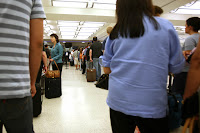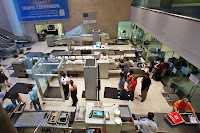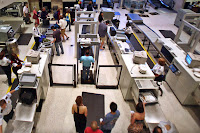Anatomy Of An Airport Security Checkpoint
Web: www.fishfotoworldwide.com — E-Mail: fish@flyingwithfish.com
2/07/2008 – Anatomy Of An Airport Security Checkpoint
I frequently discuss topics related to airport security on Flying With Fish, however this morning as I crossed the security checkpoint at New York’s JFK International Airport Terminal 7, having been awake for just under 22 hours, I realized some infrequent flyers who read this site may not know the details of a security check point. What caused me to have this revelation? It is the fact that each morning at JFK Terminal 7, as the TSA Security Screening Checkpoint opens, right around 4:45am, chaos erupts in the terminal.
The security line normally starts at the doors to enter the screening process and tends to end at the back of the terminal, usually wrapping around the corner just a bit. As the line slowly moves tensions seem to rise as passengers cut the line; private security boarding pass checkers never utters a single word to you as they grab at the boarding pass in your hand seemingly without rhyme or reason; the single line gets split into two lines; airport staff rapidly darts through the passengers and cut the line to jump to the front of the line; “CLEAR Card” users start filtering to the direct front of line……..then you meet the ID checker. Today the TSA ID Checker demanded that each passenger declare their “3-1-1” bags and she visually inspected them before sending people down the line to the actual security check point (I declared I had no “3-1-1” bag, I didn’t feel like taking my backpack off twice, as it is not the ID Checkers job to inspect your baggage or ask to see the contents of your 3-1-1 bag).
After collecting my shoes, baseball hat, the camera that was on my shoulder, stuffing my “3-1-1” bag into my backpack, stuffing my laptop back into my backpack and throwing my camera belt/pouch system over my shoulder, I looked back at a long line of very confused passengers. I’d have to think if I didn’t deal with airport security on a regular basis and I was faced with all this confusion at 4:45am, with no one explaining the process, I’d probably get a little frazzled.
In reality nearly all airport security checkpoints around the world are quite uniform in the process of security procedures.
So in the simplest terms the following is ‘The Anatomy Of An Airport Security-Screening Checkpoint.’
1) The Line Up — The Line Up is simple. It is where passengers begin to line up to enter the security-screening checkpoint. You only enter the security-screening checkpoint once you have your boarding pass (yes, I have seen people get all the way through the line only to be turned away because they forgot to pick up their boarding pass).
2) The Barker — ‘The Barker’ is the security person who walks up and down the line ‘barking’ that you should have your boarding pass and valid photo identification out and available for inspection, that your laptop should be out of your bag for x-ray inspection and that you are only entitled to only pass through security with no more than 3oz of liquids in each container, these containers must be in one single 1-quart bag and only one bag per person (hence ‘3-1-1’ bag). These people may also split a single line into two lines, ask to see you boarding pass and at times just intimidate inexperienced travelers.
3) The ID Checker — This is the security person at the ‘entrance’ to the actual screening process. This person inspects your photo identification (usually a passport or drivers license) and your travel documents to make sure your name/face match those on your boarding pass.
4) The Long Table — The actual x-ray and metal detector process usually begins with a long table with plastic bins. This is where you remove your shoes (if required); your laptop (if required); your 3-1-1 bag (now virtually universal at all security). You also want to start making sure you have no metal on you, this means place your coins, keys, mobile phone, etc in a secure pocket, or inside one of your bags.
5) The Bins — Every ‘Long Table’ has ‘The Bins.’ ‘The Bins’ are where you’ll place your shoes, jacket, laptop and other lose items. For tips on how to easily get through the x-ray process you can view my segment on ABC News’ Good Morning America here : Flying With Fish On Good Morning America.
6) The X-Ray Scanner — At the end of the ‘Long Table” is the X-Ray Scanner and its conveyor belt. You want to place your bags and bins in the X-Ray scanner. Remember that bins go in vertically NOT horizontally. Make sure you witness your bags entering the X-Ray scanner before proceeding to the next step, and from that moment never take your eyes off the ‘exit’ of the x-ray scanner! Also remember to keep your boarding pass out and in your hand, do not place that through with your bags and bins.
7) The Metal Detector — Once your bags and bins are in the x-ray scanner (and your boarding pass is in your hand!) you’ll line up for the metal detector. Always wait outside the metal detector until the security personnel have motioned for you to pass through the metal detector. Before passing through pat yourself down to check for any metal items you may have missed. If you have any loose metal items declare them before you go through the metal detector.
7a) The Metal Detector Wand (if you set off the alarm)– ‘The Wand’ is a simple hand held metal detector used by security personnel to check passengers who have set off the metal detector multiple times. You are usually hold your arms out and are ‘traced’ with the wand to find the source of the metal.
8) The Rollout — ‘The Roll-Out’ is the end of the X-Ray scanner where you retrieve your bags-n-bins. Pay attention that you have all your items and that they have exited the x-ray scanner before walking off. Take your items methodically from the x-ray scanner and if you must ‘put yourself back together’ do so at the chair or benches away from the x-ray scanner. By moving away from the x-ray scanner you’re not only allowing other passengers to proceed through, but you’re also moving to a calmer environment to put your shoes on, put your laptop away, put your 3-1-1 bag away and retrieve the small metal items you have placed in a pocket or a bag.
9) The Bag Check (should your carry on bag need a secondary screening) — There seem to be few words dreaded more than hearing “BAG CHECK LANE 7” (or whatever lane you’re in) for many passengers. Honestly, I know what my carry on bags look like and I’m personally often more concerned when I don’t here this being yelled out while the x-ray security operator is viewing my bag. A bag check is really simple. You collect all your items, just as discussed in “8) The Rollout” and a security screener carries one of your bags, in your full view, to a separate table. At that table you must never touch your items unless instructed to do so, the screener will look through tour bag and possibly wipe it down with a swab intended to detect explosives. This is not a big deal; when they are done you repack your bag (unless you have explosives in which case you have a lot of explaining to do).
10) Have A Good Flight — ‘Have A Good Fight’ is just what it sounds like……..
Below are a few photos from New York’s JFK International Airport Terminal 7 security screening checkpoint from this morning. These photos show the long dual-line leading up to the security checkpoint ; the whole screening process from the side ; the whole screening process from behind.
Hopefully the photos will put some of what I detailed in this post into a practical context for the infrequent flyers.
Happy Flying!





Great tip, except I have never seen more than 2-3 chairs near the end of the rollout, and they are somewhat in traffic. I always try to remember to wear shoes that I can easily slip back on my feet without having to stop and tie/buckle them. I also try to remember to wear socks because the idea of walking barefoot through the security process gives me the willies. I don’t know where all those other sandal-wearing feet have been.